AAC Assessment Corner with Vicki Clarke: Evaluating Skills for Use of Comprehensive AAC Dynamic Display SGDs
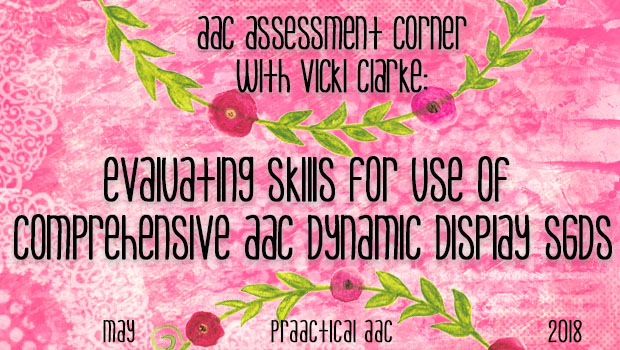
We’re always thrilled to share a guest post on AAC assessment practices from Vicki Clarke of Dynamic Therapy Associates. If you have questions about conducting AAC evaluations, read on.
guest post on AAC assessment practices from Vicki Clarke of Dynamic Therapy Associates. If you have questions about conducting AAC evaluations, read on.
You can view her previous contributions to the AAC Assessment Corner here.
::::::::::::::::::::::::::::::::::::::::::::::::::::::::::::::::::::::::::::::::::::
Evaluating Skills for Use of Comprehensive AAC Dynamic Display Systems
Part I: Early Skills
Over the past few years there has been an on-going discussion in the speech language pathology world about whether or not we needed to designate an official “specialty” recognition for augmentative and alternative communication practitioners.
The argument goes something like this: It takes a lot of extra training, concerted effort in continuing education and daily practice in the assessment and implementation of augmentative communication to do it well. Therefore, we should have a “specialty area” in our national organization, ASHA, devoted to AAC.
The counter-argument states that if our governing body says you need to “specialize” in AAC, general practitioners in the field of speech language pathology will not feel that they should (or are required to) introduce and teach their students AAC techniques. “Leave that to the experts!”
I think both arguments have some merit but I believe strongly that there are SO many people who have the potential to benefit from augmentative communication that ALL therapists, who are working with minimally verbal or nonverbal students, should have some basic AAC assessment and implementation skills. In my practice, I find I use AAC tools even with my verbal students, because these visual representations of language help students with language impairment attend to, learn and recall language concepts and vocabulary faster. Did you know that we have years of research supporting that AAC actually improves SPEECH better than speech therapy alone? AAC is a win-win. It won’t hurt your verbal students and can be life-changing for your nonverbal/minimally verbal students,
Today I thought we’d start taking a look at some of the skills needed for students to use comprehensive, dynamic display communication systems so that all of us can begin to do trials of our own. If you happen to work in a school or facility that houses their own AAC expert, you can still start testing out your theories with your students. I promise you, your AAC specialist will be thrilled to hear your outcomes and ideas!
We will work from the AAC Skills Assessment-R, a tool I designed for my own assessments and shared with everyone last year. In this post, we’ll go through the Early Skills Assessment. You can follow along with the protocol. In subsequent posts, we’ll get into the more advanced AAC features.
I. Early Skills for AAC Use
A. On-Screen Cause/Effect Assessment
This is the very first skill I look at for potential AAC users. Do they visual attend to images both on and off of screens? Some leading questions may give you a clue before you ever meet the child:
- Does the child like to watch shows or movies?
- Does the child interact with books by touching and looking?
- Does the child like to play with an iPad or another touchscreen?
To assess this when first meeting students, I use simple cause/effect apps on my iPad. There’s a list on the protocol. I have a 12” iPad Pro but you can do this on standard iPads as well.
Vision Assessment: Be aware of the visual demands of the app you are showing the child. I am on the lookout for visual processing skills in particular. Most children will look at the iPad if you put something interesting on it. If they don’t attend at all, I start asking about vision skills. If there’s no history of visual acuity problems, there may be some cortical visual issues. These children need a referral to the vision specialist and your AAC solutions may need to be modified to meet their needs (ex: high contrast symbols, object symbols, specific colors or even tactile symbols). Children with very severe cortical visual impairment may even need to access AAC in different ways. We can use high contrast images, favorite colors they can see, use object symbols, decrease the number of symbols presented at a time (simplify the visual image), or maybe even have them start working on auditory scanning. Using auditory scanning, students listen to a series of words/phrases and indicate when they hear what they want to say. They might smile to say “that’s it!” or activate a voice output switch, “that’s the one!” or activate a switch to make their scanning communication program speak the message out loud.
Sometimes we have students who visually attend but don’t physically engage. We want to ask ourselves whether this is a motor impairment? Is it weakness or coordination? Is it a fear of engaging? Get your physical/occupational therapist involved to determine if there’s a motor concern for these students. You can assess this skill using a switch to activate the iPad if so. I use the Blue 2 switch adapter for the iPad so you the iPad thinks you touched it when you activate the switch. If the child is visually engaged and interested, has fine/gross motor skills sufficient to touch and still doesn’t, you have some modeling and encouraging to do!
B. Targeting On-Screen Assessment
This portion of the assessment requires the child to target and select a specific area of the screen. I use apps with simplified images such as Peeping Musicians, Word Toob, Big Truck or Bumper Cars. I’m looking to see if the child attends to (and activates) smaller images on the screen with no other distractors. Peeping Musicians shows a small portion of the “musician” on the edge of the screen and the child has to touch that specific area to make the musician play. Like the previous skill, vision and motor access are key to successfully targeting a location on a screen, or visual display.
C. Picture Discrimination Assessment
Once we know a child can touch the screen to selec, or activate a switch to make an action occur, we can look at what happens when we give them distractors. Can they select an individual image out of a field of 9? How about 4 or 12? The difference here is that there are more distracting elements on the screen and the child should start purposefully selecting specific items of interest. You can determine how purposeful a child is selecting by observing a few key responses:
- Do they wait to see the outcome of their selection? Did they watch the screen to see the puppy appear?
- Do they seem satisfied with their selection?
- Do they repeat favored outcomes?
This is a non-communicative choice-making task. They aren’t communicating to anyone that they want a specific item/activity/outcome. They are simply making it happen themselves. This later helps us tease communication out from simply selecting buttons for cause/effect.
Does this mean students who struggle with this on-screen cause/effect, targeting and picture discrimination don’t “qualify” for AAC? Absolutely not, it just means that we may need to find ways of offering them symbols that they can access. Work with your vision specialist to make sure your symbols are optimal for your student- maybe high contrast symbols, cut-away backgrounds, preferred colors, or actual objects. Try out some auditory scanning. You can do this with your voice- no high tech device required. Work with your Occupational and Physical therapists to make sure the child can easily interact with your materials- change positions, adapt materials or provide external physical supports.
Coming Next in the AAC Assessment Corner: Language Representation Elements for AAC Use
Filed under: Featured Posts, PrAACtical Thinking
Tagged With: assessment, dynamic screen, SGDs, Vicki Clarke
This post was written by Carole Zangari

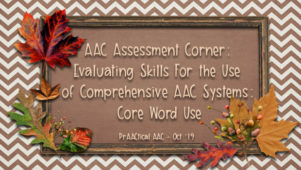
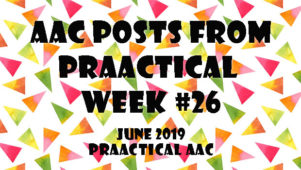
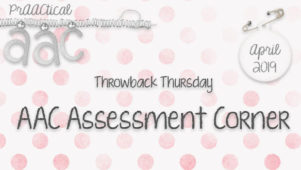
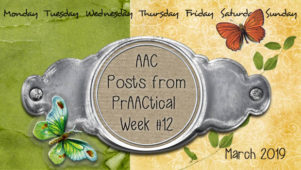
2 Comments
Thanks for the great post. We have been having very good success with auditory scanning with our students with severe CVI. It has allowed for much more vocabulary than trying to accommodate visual needs.
Also, does anyone have a good list put together of the research supporting AAC use and speech production?
I appreciate these posts so much! Thank you!